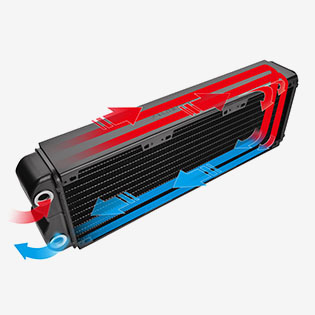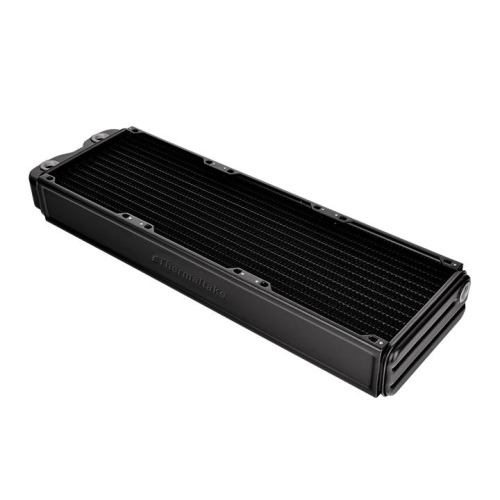Thermaltake Pacific RL420 Radiator
The Thermaltake Pacific RL Series introduces high-quality radiators to deliver outstanding water cooling performance for the enthusiast’s PC. Manufactured from high-quality German zinc alloy aluminum and aerospace-grade materials, configurations of 140mm, 280mm, 420mm, and 560mm are available to provide exceptional performance. Integrated G1/4" threads make it easy to install, while rigid connections ensure leak-resistant measures are in place. With an ideal mounting, fitting and flow set-up, the Thermaltake Pacific RL Series meets your cooling needs in every way.

Tt LCS Certified
Tt LCS Certified is a Thermaltake exclusive certification applied only to products that pass the design and hardcore enthusiasts standards that a true LCS chassis should hold to. The Tt LCS certification was created so that we at Thermaltake can indicate to all power users which chassis have been tested to be best compatible with extreme liquid cooling configurations, ensuring you get the best performance from the best features and fitment.

Optimized Heat Dispatching
Designed for the most demanding hardcore enthusiasts, the Thermaltake RL Series Radiators are optimized for maximum heat dispatching. They deliver an average heating load of 32℃-35℃ on each radiator. After brazing, the fin and tube connect to form a joint, thereby creating uniform heat transfer. By efficiently pulling heat away from the power-dissipating components, the radiators ensure component reliability.

Dual-Row Tubes
The Pacific RL Series is an extremely thick radiator with a double-row 13-set flat tube design to increase heat transfer. Water flows down on the one side, then passes across the bottom chamber before circulating back to the other side of the radiator.


High-Density Fin Design
Fin density is optimally designed to accommodate high air pressure. The cooling performance improves significantly with increased fan speed, offering exceptional cooling performance during operation. FPI (fin per inch): 13.


German-Made Anti-Corrosion Materials
Without compromise, the Pacific RL Radiator Series is designed with high-quality German aerospace-grade materials and constructed with zinc, the most common anti-corrosion agent. Although this protection will gradually degrade as the zinc corrodes away over time, it provides the best means to reduce electronic conductivity and can withstand scratches to the zinc layer. Corrosion potentials of zinc alloy aluminum can be reduced by 55.6% after brazing.

High-Quality Manufacturing Process: Brazing
An exceptional manufacturing process using high temperature brazing at 1022℉/550℃ sets Pacific RL Radiators in a class of their own. This technique allows for impurities to be kept out of the brazing process, ensuring that full strength on all the connected areas is achieved. The radiators are baked through a controlled atmosphere brazing line. The materials melt into each other to accomplish optimal thermal transfer from the tubes to the actual fins in order to attain better heat evacuation.

Radiator Production Process Video
Remarkable Expansion
The Pacific RL Radiator Series provides multiple sizes for users to build the ultimate in custom configurations. A wide array of radiator sizes are available for enthusiasts to build up aesthetically-superior water cooling systems by allocating the radiators to each particular component and incorporating externally-modular upgrades for their chassis.


Cautions
Thermaltake recommends the following steps to be taken before using the Pacific series radiators and water blocks
- To ensure a clean loop, flush and rinse your radiators and water blocks with distilled water prior to use.
- Do not use tap water or distilled water as your coolant, it may harm your loop and reduce performance.
- It is strongly recommended to use market proven pre-mix coolant, such as Thermaltake Coolant 1000. It offers great performance while protecting the entire liquid loop from corrosion.
- Before storing your water cooling components, please clean, rinse and dry. This will ensure a longer lifespan for your components.
Thermaltake recommends the following steps to be taken after completing your water loop setup
- It is strongly recommended to use market proven pre-mix coolant, such as Thermaltake Coolant 1000. It offers great performance while preventing the entire cooling system – copper, brass, nickel, aluminum, and steel – from corrosion.
- Fill the reservoir with coolant and cycle the power on and off several times while the pump pushing the coolant into the loop.
- DO NOT let the pump run dry, when there is no liquid entering the pump turn off your power immediately
- Fill the reservoir to the top as it will prevent air from going into the pump
- If necessary tilt the system slightly from side to side to bleed the air out of the loop.
- Place some paper towels under fittings and joining points to test for leaks.
- Run the loop with the fill port open for about 24 hours to completely bleed the air out of the loop.
Uwagi
Thermaltake zaleca następujące kroki, które należy podjąć przed użyciem chłodnic i bloków wodnych z serii Pacific:
- Aby zapewnić czystą pętlę, przed użyciem przepłucz chłodnice i bloki wodne wodą destylowaną.
- Nie używaj wody z kranu ani wody destylowanej jako chłodziwa, może to uszkodzić pętlę i zmniejszyć wydajność.
- Zdecydowanie zaleca się stosowanie sprawdzonego na rynku wstępnie zmieszanego płynu chłodzącego, takiego jak Thermaltake Coolant 1000. Zapewnia on doskonałą wydajność, jednocześnie chroniąc cały obieg cieczy przed korozją.
- Przed przechowywaniem elementów do chłodzenia wodą należy je wyczyścić, wypłukać i wysuszyć. Zapewni to dłuższą żywotność komponentów.
Thermaltake zaleca następujące kroki, które należy wykonać po zakończeniu konfiguracji pętli wodnej:
- Zdecydowanie zaleca się stosowanie sprawdzonego na rynku wstępnie zmieszanego płynu chłodzącego, takiego jak Thermaltake Coolant 1000. Zapewnia on doskonałą wydajność, jednocześnie zapobiegając korozji całego układu chłodzenia – miedzi, mosiądzu, niklu, aluminium i stali.
- Napełnij zbiornik płynem chłodzącym i kilkakrotnie włączaj i wyłączaj zasilanie, podczas gdy pompa wpycha płyn chłodzący do pętli.
- NIE pozwól, aby pompa pracowała na sucho; jeśli do pompy nie dostanie się płyn, natychmiast wyłącz zasilanie.
- Napełnij zbiornik do góry, aby zapobiec przedostawaniu się powietrza do pompy.
- W razie potrzeby lekko przechylić system na boki, aby wypuścić powietrze z pętli.
- Umieść kilka ręczników papierowych pod łącznikami i punktami łączenia, aby sprawdzić, czy nie ma wycieków.
- Uruchom pętlę z otwartym portem napełniania na około 24 godziny, aby całkowicie usunąć powietrze z pętli.
- Przed rozpoczęciem należy dokładnie przepłukać system, aby zapobiec przywieraniu chłodziwa lub niepożądanych cząstek do rur, chłodnic i innych elementów chłodzących.
- Płyn chłodzący może z czasem wyblaknąć.
| P/N | CL-W017-AL00BL-A |
|---|---|
| MATERIAŁ | Anti-Corrosion Aluminum Alloy |
| Wymiary | 462.5 (L) x 140 (W) x 56 (H) |
| Waga | 1070 g |
| FPI (Fin per inch) | 13 |
| RURKA PŁASKA | 13 set |
| Części | Stopper *3 (G 1/4 ) |
| Gwint | G 1/4 * 5 |
User Manual
- Nazwa pliku
- Opis
- Rozmiar
- Version
- Release Date











